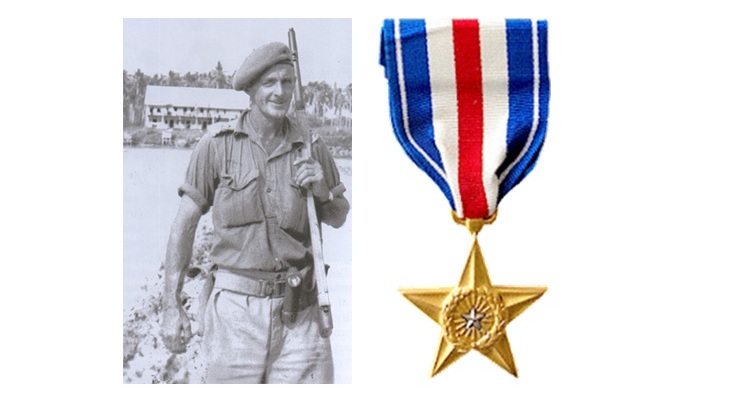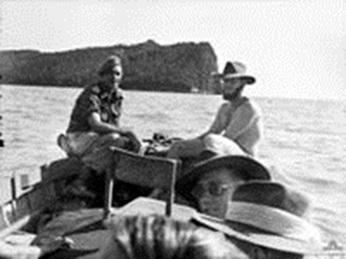Australian Guerilla In Mindanao: Capt. Jock McLaren AIF

Robert Kerr “Jock” McLaren (27 April 1902 – 3 March 1956) was a decorated Australian Army officer, who rose from enlisted rank and was noted for his involvement in guerrilla operations against the Japanese during World War II
McLaren was born on 27 April 1902 in Kirkcaldy, Scotland. His father was James Bryce McLaren, a chemist, while his mother was Annie Maxwell (née Kerr).
During World War I, McLaren served in the British Army with the 51st Highland Division. After the war he moved to Queensland, Australia where he served as a veterinary officer in Bundaberg. In 1938, he married Catherine Ahern in Childers
Following the outbreak of World War II, he continued to serve as a veterinary officer, although he joined the Citizens Military Force in March 1941. Shortly after, he volunteered for overseas service and opted to transfer to the Australian Imperial Force. He was assigned to the 2/10th Australian Field Workshops with the 8th Australian Division in British Malaya when Singapore fell to the Japanese army. At this time, he was thirty-nine years old.
He could not endure imprisonment and immediately organized an escape party. Escaping from the POW camp with two comrades, they successfully made it almost to Kuala Lumpur, often with the aid of Malayan Chinese and Chinese communist guerrillas, before they were betrayed to the Japanese by Malays. It was during this escape that McLaren began to hate the Japanese as he passed the bodies of hundreds of Chinese men, women and children, who had been tortured, raped, and then killed by Japanese occupation forces.
Imprisoned once again, McLaren sought to escape from the Singapore prison camps. He managed to add himself to a contingent of prisoners being sent to Borneo to a labor camp. Once he arrived at Berhala Island, in Sandakan Harbour on northeastern Borneo, he began, with several other prisoners, to plan an escape. His recapture did not dent his determination to escape. The move to Borneo just meant he was that much closer to home. Hearing that they will be sent to a more permanent camp at Sandakan with less opportunity for escape He quickly teamed up with someone as determined to escape as he was — a local Chinese man named Johnny Funk, who had been brutally tortured by the Japanese. Together, Jock and Johnny broke out of prison and trekked to the coast. They then island-hopped for 430 kilometers across the Pacific in a canoe made out of a hollowed-out log stolen from a nearby leper colony, fighting running battles with the Japanese along the way. McLaren eventually came into contact with other Australians and Filipino guerrillas on a mission from Tawi-tawi.
In Mindanao, McLaren and his comrades made contact with American and Filipino guerrillas under the overall command of Lt. Col. Wendell Fertig. Their hopes of returning to Australia to join formal army units were curtailed due to the need for experienced leaders for the guerrilla forces and lack of transportation. Eventually, some of the party was sent to Australia by submarine.
On August 1944, Robert “Jock” Mclaren, a trained Military Veterinary Surgeon made his first appendectomy on a human being, the patient was of course, himself.
“I knew I had appendicitis and if I did not do something I would die,” said Capt. .McLaren. “With the aid of a mirror and an ordinary knife I took out the appendix.’” he said. The operation took 4.5 hours. ”It was hell, but I came through all right,” added Capt. .McLaren. “I used jungle fiber to stitch the wound.” Manila hemp is made from the abaca fiber. A Filipino guerilla that had some experience in suturing wounds helped McLaren during the whole process as others stood by during the operation. Tea made out of guava leaves was used to clean the wound. All this was done without ether to dull the pain. Two days later, McLaren was up and about and dodging the Japs again.
Surprisingly, McLaren wished to remain behind, as transfer to a formal unit would not only inhibit his actions and desire for revenge, but his age would preclude participation in combat.
In Mindanao, McLaren was assigned by Col. Fertig to the 108th Division as a coast watcher. Early September, he reported sighting a convoy of Japanese ships heading to Manila. The Information that he gathered from local spies said that it was carrying up to 3000 Japanese troops. The convoy was promptly ambushed by the USS Paddle an American submarine. Unfortunately, one of the ships sunk was the hellship “Shinyu Maru” with 687 allied prisoners on board. Filipino Guerrillas in the area were able to rescue 82 Americans. The Japanese soldiers and sailors who survived their watery ordeal reached shore exhausted and in no condition to fight were killed by the guerrillas.
During one period of his service in the Philippines, McLaren commanded a 26-foot whaleboat called “The Bastard”. It was armed with a .50 cal. Heavy Machinegun and an 81mm Mortar. He attacked a Japanese wharf full of supplies and sunk a small launch. He destroyed a lot of Jap Equipment and killed a lot of Japanese soldiers too. Before the Japanese could react, the “Bastard” has turned its tail and escaped.
“McLaren skippered an armed whaleboat off Mindanao. He attacked Japanese small craft and coastal installations with dash and aggression, qualities he also displayed when commanding combat patrols on land. On 2 April 1945 he and Blow headed elements of the guerrilla force’s 108th Division in an assault on the last Japanese stronghold in Lanao province. Lieutenant Colonel Charles W. Hedges, the American divisional commander, recorded that the fighting ended with the capture of the garrison and the destruction of about 450 enemy troops. For his efforts at sea and on land, McLaren won the Military Cross and was mentioned in dispatches. His M.C. citation read: ‘throughout the whole of his service with the Guerilla Forces, Captain McLaren displayed outstanding leadership in battle and had no regard for his personal safety. His cheerful imperturbability was an inspiration to all with whom he came into contact’. The Americans awarded him the Philippines Liberation ribbon and was awarded the Silver Star the third highest award given by the US Military by Gen. Douglas MacArthur himself.”
As senior officers at both the guerrilla unit and army levels began to appreciate his initiative and dependability, he was often assigned to make small unit and solo forays into Japanese held areas for intelligence. Toward the end of the war, high-level U.S. and Australian commands relied on him to penetrate Japanese areas in the Philippines and former Dutch colonies ahead of planned invasions for the latest intelligence and to scout possible enemy routes of retreat which could then be interdicted. As a member of the American forces in the Philippines, McLaren was under U.S. command. However, on 20 April 1945, upon the request of the Australians who had a need for his talents, General Eichelberger personally signed an order releasing McLaren back to Australian command.
After being transferred to Z Special Unit, under the command of the Services Reconnaissance Department, attached to the Allied Intelligence Bureau, McLaren subsequently took part in an airborne operation near Balikpapan in late June 1945. Dropping in advance of the main Allied landing in early July 1945, McLaren led a section of four men on a reconnaissance mission. Despite losing two men, one from injury following the landing and another in an ambush, McLaren and the other two men were able to return to Australian lines on 6 July and report the Japanese dispositions to the Australian 7th Division’s headquarters. Following this, in late July, McLaren took part in an operation on British North Borneo, leading an eight man section. It was his last operation of the war, and after hostilities he remained in Borneo to help re-establish administration before being returned to Australia in November 1945.
Having been promoted to sergeant soon after joining the guerrilla forces, Jock McLaren later received a field commission from Australia and ended the war with the substantive rank of captain. During the course of his service, McLaren was decorated with the Military Cross twice for his heroic actions, as well as being Mentioned in Dispatches.
Following the end of the war, McLaren was discharged from the AIF and transferred to the Reserve of Officers List in early 1946. Following this he became a government veterinarian in New Guinea. He remained in this role until 1956 when he began growing coffee, buying a plantation at Wau. On 3 March 1956, McLaren was accidentally killed when rotted timber fell on him near his home after he backed a vehicle against a dead tree.





